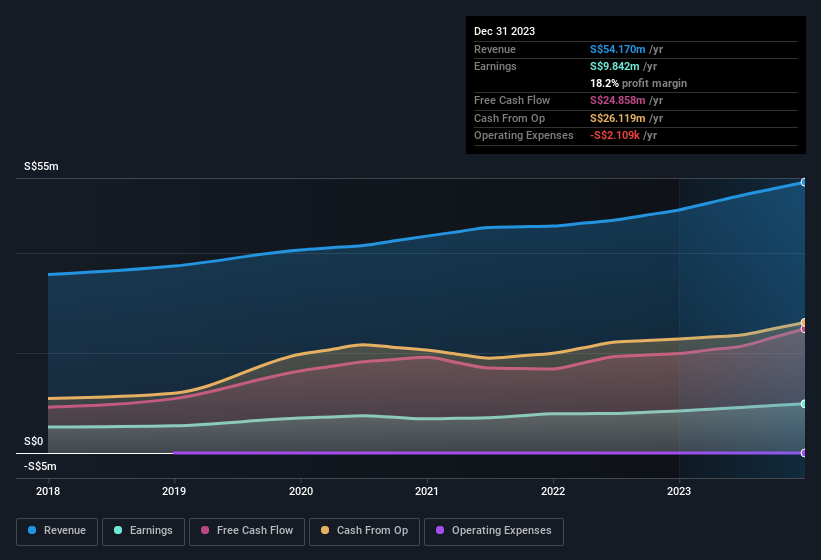- Singapore
- /
- Professional Services
- /
- SGX:TCU
Credit Bureau Asia's (SGX:TCU) Earnings Offer More Than Meets The Eye

The market seemed underwhelmed by last week's earnings announcement from Credit Bureau Asia Limited (SGX:TCU) despite the healthy numbers. We did some digging, and we think that investors are missing some encouraging factors in the underlying numbers.
View our latest analysis for Credit Bureau Asia

A Closer Look At Credit Bureau Asia's Earnings
Many investors haven't heard of the accrual ratio from cashflow, but it is actually a useful measure of how well a company's profit is backed up by free cash flow (FCF) during a given period. The accrual ratio subtracts the FCF from the profit for a given period, and divides the result by the average operating assets of the company over that time. This ratio tells us how much of a company's profit is not backed by free cashflow.
That means a negative accrual ratio is a good thing, because it shows that the company is bringing in more free cash flow than its profit would suggest. While having an accrual ratio above zero is of little concern, we do think it's worth noting when a company has a relatively high accrual ratio. That's because some academic studies have suggested that high accruals ratios tend to lead to lower profit or less profit growth.
Credit Bureau Asia has an accrual ratio of -0.75 for the year to December 2023. Therefore, its statutory earnings were very significantly less than its free cashflow. To wit, it produced free cash flow of S$25m during the period, dwarfing its reported profit of S$9.84m. Credit Bureau Asia shareholders are no doubt pleased that free cash flow improved over the last twelve months.
That might leave you wondering what analysts are forecasting in terms of future profitability. Luckily, you can click here to see an interactive graph depicting future profitability, based on their estimates.
Our Take On Credit Bureau Asia's Profit Performance
Happily for shareholders, Credit Bureau Asia produced plenty of free cash flow to back up its statutory profit numbers. Based on this observation, we consider it possible that Credit Bureau Asia's statutory profit actually understates its earnings potential! And on top of that, its earnings per share have grown at 27% per year over the last three years. The goal of this article has been to assess how well we can rely on the statutory earnings to reflect the company's potential, but there is plenty more to consider. So while earnings quality is important, it's equally important to consider the risks facing Credit Bureau Asia at this point in time. For example - Credit Bureau Asia has 1 warning sign we think you should be aware of.
This note has only looked at a single factor that sheds light on the nature of Credit Bureau Asia's profit. But there are plenty of other ways to inform your opinion of a company. Some people consider a high return on equity to be a good sign of a quality business. While it might take a little research on your behalf, you may find this free collection of companies boasting high return on equity, or this list of stocks that insiders are buying to be useful.
New: AI Stock Screener & Alerts
Our new AI Stock Screener scans the market every day to uncover opportunities.
• Dividend Powerhouses (3%+ Yield)
• Undervalued Small Caps with Insider Buying
• High growth Tech and AI Companies
Or build your own from over 50 metrics.
Have feedback on this article? Concerned about the content? Get in touch with us directly. Alternatively, email editorial-team (at) simplywallst.com.
This article by Simply Wall St is general in nature. We provide commentary based on historical data and analyst forecasts only using an unbiased methodology and our articles are not intended to be financial advice. It does not constitute a recommendation to buy or sell any stock, and does not take account of your objectives, or your financial situation. We aim to bring you long-term focused analysis driven by fundamental data. Note that our analysis may not factor in the latest price-sensitive company announcements or qualitative material. Simply Wall St has no position in any stocks mentioned.
About SGX:TCU
Credit Bureau Asia
An investment holding company, provides credit and risk information solutions in Singapore, Malaysia, Cambodia, and Myanmar.
Outstanding track record with flawless balance sheet.
Market Insights
Community Narratives



